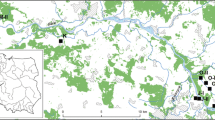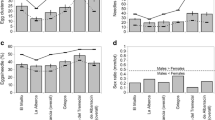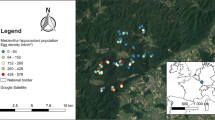Abstract
Phytophagous insects have many strategies to escape parasitoids, for example by hiding eggs into plant tissues, but oviposition in holes made by another insect is rather scarce. The cypress seed bug Orsillus maculatus Fieber (Heteroptera: Lygaeidae) is strictly dependent on the availability of cones of Cupressus sempervirens L. to oviposit. Females lay eggs either in exit holes cut through the cone scale by emerging adults of the cypress seed chalcid, Megastigmus wachtli Seitner (Hymenoptera: Torymidae), or on the inner side of scales of partly open cones. A recently discovered egg parasitoid belonging to the genus Telenomus has been shown to attack bug eggs in both oviposition sites. In this paper we investigated the parasitoid performance according to oviposition sites. Field samplings were conducted in two evergreen cypress orchards located in the south of France. The distribution and condition of the egg patches were compared between the two locations and oviposition sites. Seed bugs preferred to oviposit in emergence holes of M. wachtli, and parasitoid performance was higher in eggs laid on cone scales. The chalcid emergence holes seemed to ensure bug eggs with enemy-free space. Oviposition site selection could be an adaptive strategy to escape parasitoid attack.
Similar content being viewed by others
References
Al-Wahaibi A.K., Walker G.P. (2000a). Oviposition behavior of Anagrus nigriventris, an egg parasitoid of beet leafhopper, Circulifer tenellus. BioControl 45:139–153
Al-Wahaibi A.K., Walker G.P., (2000b). Searching and oviposition behavior of a mymarid egg parasitoid, Anagrus nigriventris, on five host plant species of its leafhopper host, Circulifer tenellus. Entomol. Exp. Appl. 96:9–25
Ballabeni P., Wlodarczik M., Rahier M. (2001). Does enemy-free space for eggs contribute to a leaf beetle’s oviposition preference for a nutritionally inferior host plant?. Funct. Ecol. 15:318–324
Battisti A., Colombari F., Frigimelica G., Guido M., (1997). Life history of Orsillus maculatus, a true bug damaging seeds of Cupressus sempervirens. In: Battisti A., Turgeon J. (eds). Proceedings of the 5th Cone and Seed Insects Working Party Conference. Institute of Agricultural Entomology, Padova Italy, pp. 215–220
Battisti A., Roques A., Colombari F., Frigimelica G., Guido M. (1999). Efficient transmission of an introduced pathogen via an ancient insect-fungus association. Naturwissenschaften 86:479–483
Battisti, A., R. Cantini, G. Rouault and A. Roques, 2003. Serotinous cones of Cupressus sempervirens provide viable seeds in spite of high seed predation. Ann. For. Sci. 60: 781–787
Bayram A., Salemo G., Conti E., Wajnberg E., Bin F., Komosor S. (2004). Sex allocation in Telenomus busseolae, a solitary parasitoid of concealed eggs: The influence of host patch size. Entomol. Exp. Appl. 111:141–149
Bin F., Vinson S.B. (1990). Efficacy assessment in egg parasitoids (Hymenoptera): proposal for a unified terminology. In: Wajnberg E. and S.B. Vinson (eds), Trichogramma and Other Egg Parasitoids. 3rd International Symposium. Les Colloques de l’INRA 56, INRA Editions, Paris, pp. 175–179
Björkman C., Larsson S., Bommarco R. (1997). Oviposition preferences in pine sawflies: A trade-off between larval growth and defence against natural enemies. Oikos 79:45–52
Blatt S.E., Borden J.H. (1998). Interactions between the Douglas-fir seed chalcid, Megastigmus spermotrophus (Hymenoptera: Torymidae), and the western conifer seed bug, Leptoglossus occidentalis (Hemiptera : Coreidae). Can. Entomol. 130:775–782
Carcreff E., Rasplus J.-Y., Roques A., Mondor G., Vautrin D., Solignac M. (1998). Isolation and characterisation of microsatellite loci in the seed chalcid Megastigmus wachtli (Hymenoptera). Mol. Ecol. 7:251–253
Conti E., Bin F. (2000). Parasitoids of concealed noctuids eggs and their potential in biological control of gramine stemborers. Redia 83:87–104
Conti E., Jones W.A., Bin F., Vinson B. (1996). Physical and chemical factors involved in host recognition behavior of Anaphes iole Girault, an egg parasitoid of Lygus hesperus Knight (Hymenoptera: Mymaridae; Heteroptera: Miridae). Biol. Control 7:10–16
Conti E., Jones W.A., Bin F., Vinson B. (1997). Oviposition behavior of Anaphes iole, an egg parasitoid of Lygus hesperus (Hymenoptera: Mymaridae; Heteroptera: Miridae). Ann. Entomol. Soc. Am. 90:91–101
Conti E., Roversi P.F., Bin F. (2000). Morphofunctional adaptations of parasitoids attacking concealed eggs of two arboreal mirids in Italy. J. Hymenopteran Res. 9:385–394
Denno R.F., Larsson S., Olmstead K.L. (1990). Role of enemy-free space and plant quality in host-plant selection by willow beetles. Ecology 71:124–137
Dicke, M. and P. Grostal, 2003. Chemical detection of natural enemies by arthropods: an ecological perspective. Annu. Rev. Ecol. Syst. 32:1–23
Fiaboe M.K., Chabi-Olaye A., Gounou S., Smith H., Borgemeister C., Schulthess F. (2003). Sesamia calamistis calling behavior and its role in host finding of eggs parasitoids Telenomus busseolae, Telenomus isis, ans Lathromeris ovicida. J. Chem. Ecol. 29:921–929
Fox L.R., Eisenbach J. (1992). Contrary choice: possible exploitation of enemy-free space by herbivorous insects in cultivated vs. wild crucifers. Oecologia 89:574–579
Garcia-Gonzalez F., Gomendio M. (2003). Oviposition site selection and oviposition stimulation by conspecifics in the golden egg bug (Phyllomorpha laciniata): implications for female fitness. Behav. Ecol. Sociobiol. 53:385–392
Godfray H.J.C. (1994). Parasitoids: behavioural and evolutionary ecology. Princeton University Press, Princeton
Hilker M., Meiners T. (2002). Induction of plant responses to oviposition and feeding by herbivorous arthropods: a comparison. Entomol. Exp. Appl. 104:181–192
Hopkins G.W., Dixon A.F.G., (1997). Enemy-free space and the feeding niche of an aphid. Ecol. Entomol. 22:271–274
Hougardy E., Grégoire J-C. (2004). Biological differences reflect host preference in two parasitoids attacking the bark beetle Ips typographus (Coleoptera: Scolytidae) in Belgium. Bull. Entomol. Res. 94:341–347
Gross, P., 1993. Insect behavioural and morphological defences against parasitoids. Ann. Rev. Entomol. 38:252–273
Kenis M. (1997). Biology of Coeloides sordidator (Hymenoptera: Braconidae), a possible candidate for introduction against Pissodes strobi (Coleoptera: Curculionidae) in North America. Biocontrol Sci. Tech. 7:153–164
Leather S.R., Ahmed S.I., Hogan L. (1994). Adult feeding preferences of the large pine weevil, Hylobius abietis (Coleoptera: Curculionidae). Eur. J. Entomol. 91:385–389
Mayhew P.J. (2001). Herbivore host choice and optimal bad motherhood. Trends Ecol. Evol. 16:165–167
Meiners T., Obermaier E. (2004). Hide and seek on two spatial scales-vegetation structure effects herbivore oviposition and egg parasitism. Basic Appl. Ecol. 5:87–94
Pettersson E.M., Birgersson G., Witzgall P. (2001). Synthetic attractants for the bark beetle parasitoid Coeloides bostrichorum Giraud (Hymenoptera: Braconidae). Naturwissenschaften 88:88–91
Potting R.P.J., Overholt W.A., Danso F.O., Takasu K., (1997). Foraging behavior and life history of the stemborer parasitoid Cotesia flavipes (Hymenoptera: Braconidae). J. Insect Behav. 10:13–29
Potting R.P.J., Vet L.E.M., Dicke M. (1995). Host microhabitat location by the stemborer parasitoid Cotesia flavipes: the role of herbivores volatiles and locally and systemically induced plant volatiles. J. Chem. Ecol. 21:535–539
Reguera P., Gomendio M. (2002). Flexible oviposition behavior in the golden egg bug (Phyllomorpha laciniata) and its implications for offspring survival. Behav. Ecol. 13:70–74
Romeis J., Shanower T.G., Zebitz C.P.W. (1998). Physical and chemical plant characters inhibiting the searching behavior of Trichogramma chilonis. Entomol. Exp. Appl. 87:275–284
Roques A. (1983). Les insectes ravageurs des cônes et des graines de conifères en France. INRA Editions, Paris
Rose A.H. and Lindquist O.H. (1973). Insectes des pins de l’Est du Canada. Service Canadien des Forêt, Ottawa
Rouault G., Roversi P.F., Cantini R., Battisti A., Bouaziz K., Roques A. (2000). First record of an egg parasitoid (Telenomus gr. floridanus, Hymenoptera Scelionidae) of two true seed bugs (Heteroptera Lygaeidae) living on Cupressaceae. Redia 83:163–173
Rouault G., Cantini R., Battisti A., Roques A. (2005). Geographic distribution and ecology of two species of Orsillus (Heteroptera: Lygaeidae) associated with cones of native and introduced Cupressaceae in Europe and in the Mediterranean basin. Can. Entomol. 137:450–470
Scheirs J., De Bruyn L., Verhagen R. (2000). Optimization of adult performances determines host choice in a grass miner. Proc. R. Soc. London B 267:2065–2069
Schreiber S.J., Fox L.R., Getz W.M. (2000). Coevolution of contrary choices in host-parasitoid systems. Am. Nat. 155:637–648
Shiojiri K., Takabayashi J. (2003). Effects of specialist parasitoids on oviposition preference of phytophagous insects: encounter–dilution effects in a tri-trophic interaction. Ecol. Entomol. 28:573–578
Shiojiri K., Takabayashi J., Yano S., Takafuji A. (2002). Oviposition preferences of herbivores are affected by tritrophic interaction webs. Ecol. Lett. 5:186–192
Takasu K., Nordlund D.A. (2001). Host recognition for Anapheles iole Girault, an egg parasitoid of the Western Tarnished plant bug. Biol. Control 22:60–65
Treacy M.F.J.H., Benedict J.H., Segers J.C., Morrison R.K., Lopez J.D. (1986). Role of cotton trichome density in bollworm (Lepidoptera: Noctuidae) egg parasitism. Environ. Entomol. 15:365–368
Udayagiri S., Welter S.C. (2000). Escape of Lygus hesperus (Heteroptera: Miridae) eggs from parasitism by Anaphes iole (Hymenoptera: Mymaridae) in Strawberries: plant structure effects. Biol. Control 17:234–242
Vet L.E.M., Dicke M. (1992). Ecology of infochemichals use by natural enemies in a tritrophic context. Annu. Rev. Entomol. 37:141–172
Vos M., Berrocal S.M., Karamaouna F., Hemerick L., Vet L.E.M. (2001). Plant-mediated indirect effects and the persistence of parasitoid-herbivore communities. Ecol. Lett. 4:38–45
Waage J., Greathead D. (1986). Insect parasitoids. Academic Press, London
Williams I.S., Jones T.H., Hartley S.E., (2001). The role of resources and natural enemies in determining the distribution of an insect herbivore population. Ecol. Entomol. 26:204–211
Zar J.H. (1999). Biostatistical analysis, 4th edn. Prentice Hall, Upper Saddle River, New Jersey
Acknowledgements
We are grateful to J.-P. Raimbault and C. Lézier for their help in field samplings. G. Rouault was supported by a scholarship from Région Centre in France and A. Battisti by the grant Ecocypre of the Trento district, Italy.
Author information
Authors and Affiliations
Corresponding author
Rights and permissions
About this article
Cite this article
Rouault, G., Battisti, A. & Roques, A. Oviposition Sites of the Cypress Seed Bug Orsillus maculatus and Response of the Egg Parasitoid Telenomus gr. Floridanus . Biocontrol 52, 9–24 (2007). https://doi.org/10.1007/s10526-006-9002-z
Received:
Accepted:
Published:
Issue Date:
DOI: https://doi.org/10.1007/s10526-006-9002-z




